ITC595 Research Project: Cryptography for Data Security
VerifiedAdded on 2022/10/04
|6
|2850
|25
Report
AI Summary
This report delves into the realm of cryptography, focusing on its critical role in securing data in today's technologically advanced world. It begins with an overview of data security challenges and the significance of cryptography in protecting information from threats like hacking and phishing. The report then explores various cryptographic algorithms, including symmetric key algorithms such as AES, DES, and 3DES, and asymmetric key algorithms like RSA and Diffie-Hellman. It explains the principles behind these algorithms, their strengths, and weaknesses, and their applications in ensuring confidentiality, integrity, and authentication of data. The discussion covers the importance of cryptography in various sectors, including business, military, and international diplomacy, highlighting how encryption prevents unnecessary costs and ensures efficient information management. The report emphasizes the need for robust security mechanisms to protect against vulnerabilities in internet services and applications. The document is a comprehensive guide for beginners, providing essential knowledge about different types of cryptographic algorithms, their significance, and their application in securing critical data in the modern era.
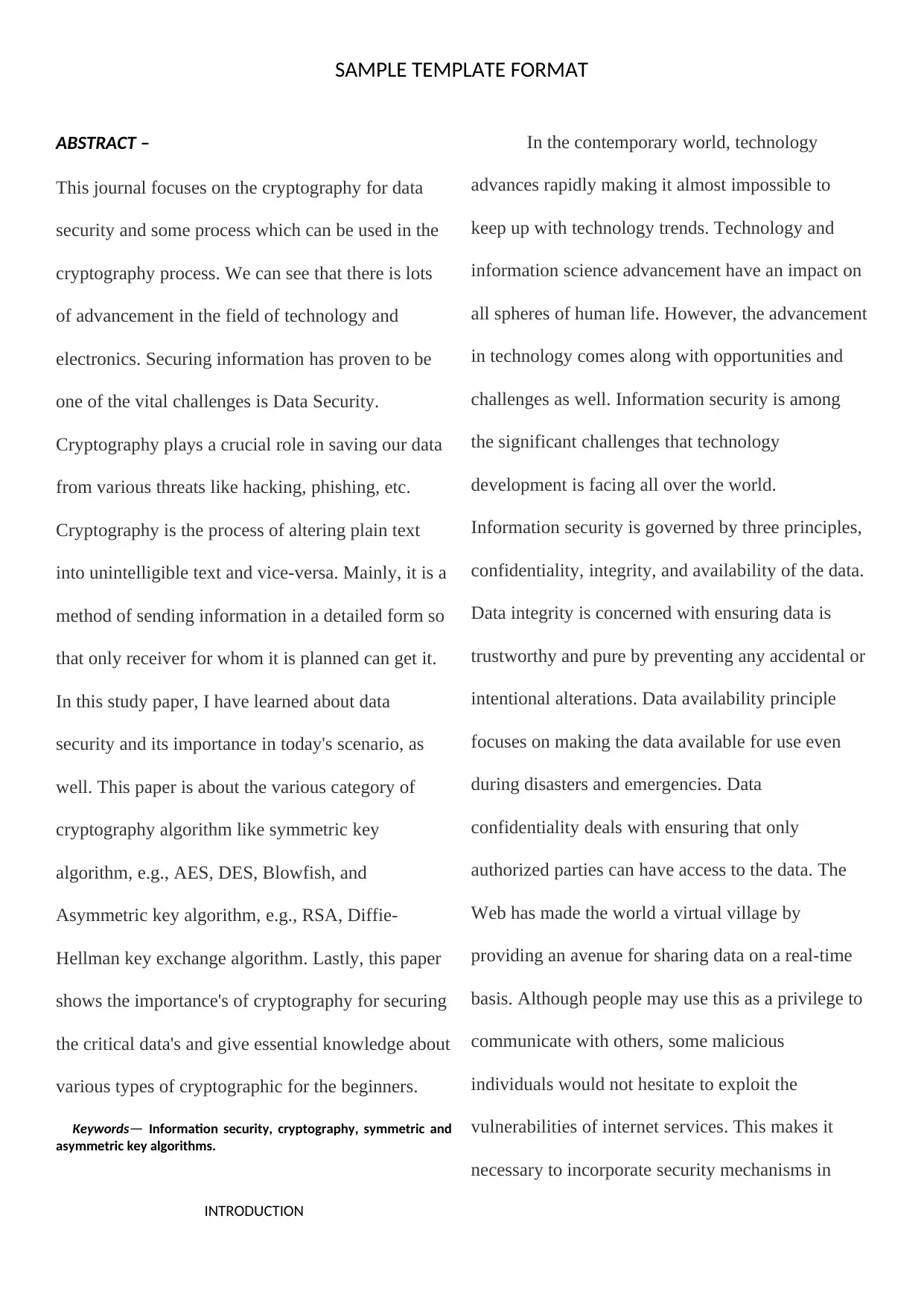
SAMPLE TEMPLATE FORMAT
ABSTRACT –
This journal focuses on the cryptography for data
security and some process which can be used in the
cryptography process. We can see that there is lots
of advancement in the field of technology and
electronics. Securing information has proven to be
one of the vital challenges is Data Security.
Cryptography plays a crucial role in saving our data
from various threats like hacking, phishing, etc.
Cryptography is the process of altering plain text
into unintelligible text and vice-versa. Mainly, it is a
method of sending information in a detailed form so
that only receiver for whom it is planned can get it.
In this study paper, I have learned about data
security and its importance in today's scenario, as
well. This paper is about the various category of
cryptography algorithm like symmetric key
algorithm, e.g., AES, DES, Blowfish, and
Asymmetric key algorithm, e.g., RSA, Diffie-
Hellman key exchange algorithm. Lastly, this paper
shows the importance's of cryptography for securing
the critical data's and give essential knowledge about
various types of cryptographic for the beginners.
Keywords— Information security, cryptography, symmetric and
asymmetric key algorithms.
INTRODUCTION
In the contemporary world, technology
advances rapidly making it almost impossible to
keep up with technology trends. Technology and
information science advancement have an impact on
all spheres of human life. However, the advancement
in technology comes along with opportunities and
challenges as well. Information security is among
the significant challenges that technology
development is facing all over the world.
Information security is governed by three principles,
confidentiality, integrity, and availability of the data.
Data integrity is concerned with ensuring data is
trustworthy and pure by preventing any accidental or
intentional alterations. Data availability principle
focuses on making the data available for use even
during disasters and emergencies. Data
confidentiality deals with ensuring that only
authorized parties can have access to the data. The
Web has made the world a virtual village by
providing an avenue for sharing data on a real-time
basis. Although people may use this as a privilege to
communicate with others, some malicious
individuals would not hesitate to exploit the
vulnerabilities of internet services. This makes it
necessary to incorporate security mechanisms in
ABSTRACT –
This journal focuses on the cryptography for data
security and some process which can be used in the
cryptography process. We can see that there is lots
of advancement in the field of technology and
electronics. Securing information has proven to be
one of the vital challenges is Data Security.
Cryptography plays a crucial role in saving our data
from various threats like hacking, phishing, etc.
Cryptography is the process of altering plain text
into unintelligible text and vice-versa. Mainly, it is a
method of sending information in a detailed form so
that only receiver for whom it is planned can get it.
In this study paper, I have learned about data
security and its importance in today's scenario, as
well. This paper is about the various category of
cryptography algorithm like symmetric key
algorithm, e.g., AES, DES, Blowfish, and
Asymmetric key algorithm, e.g., RSA, Diffie-
Hellman key exchange algorithm. Lastly, this paper
shows the importance's of cryptography for securing
the critical data's and give essential knowledge about
various types of cryptographic for the beginners.
Keywords— Information security, cryptography, symmetric and
asymmetric key algorithms.
INTRODUCTION
In the contemporary world, technology
advances rapidly making it almost impossible to
keep up with technology trends. Technology and
information science advancement have an impact on
all spheres of human life. However, the advancement
in technology comes along with opportunities and
challenges as well. Information security is among
the significant challenges that technology
development is facing all over the world.
Information security is governed by three principles,
confidentiality, integrity, and availability of the data.
Data integrity is concerned with ensuring data is
trustworthy and pure by preventing any accidental or
intentional alterations. Data availability principle
focuses on making the data available for use even
during disasters and emergencies. Data
confidentiality deals with ensuring that only
authorized parties can have access to the data. The
Web has made the world a virtual village by
providing an avenue for sharing data on a real-time
basis. Although people may use this as a privilege to
communicate with others, some malicious
individuals would not hesitate to exploit the
vulnerabilities of internet services. This makes it
necessary to incorporate security mechanisms in
Paraphrase This Document
Need a fresh take? Get an instant paraphrase of this document with our AI Paraphraser
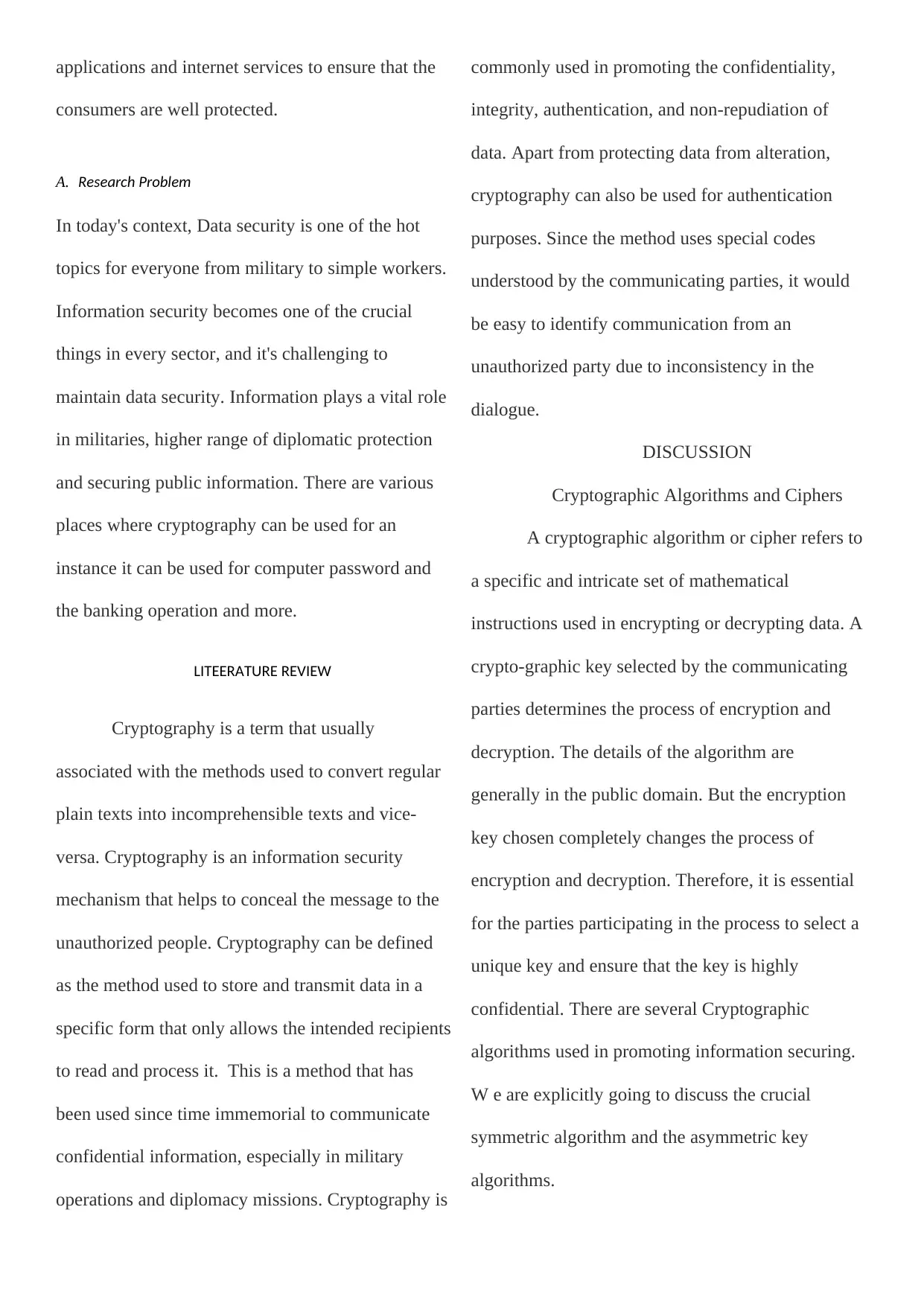
applications and internet services to ensure that the
consumers are well protected.
A. Research Problem
In today's context, Data security is one of the hot
topics for everyone from military to simple workers.
Information security becomes one of the crucial
things in every sector, and it's challenging to
maintain data security. Information plays a vital role
in militaries, higher range of diplomatic protection
and securing public information. There are various
places where cryptography can be used for an
instance it can be used for computer password and
the banking operation and more.
LITEERATURE REVIEW
Cryptography is a term that usually
associated with the methods used to convert regular
plain texts into incomprehensible texts and vice-
versa. Cryptography is an information security
mechanism that helps to conceal the message to the
unauthorized people. Cryptography can be defined
as the method used to store and transmit data in a
specific form that only allows the intended recipients
to read and process it. This is a method that has
been used since time immemorial to communicate
confidential information, especially in military
operations and diplomacy missions. Cryptography is
commonly used in promoting the confidentiality,
integrity, authentication, and non-repudiation of
data. Apart from protecting data from alteration,
cryptography can also be used for authentication
purposes. Since the method uses special codes
understood by the communicating parties, it would
be easy to identify communication from an
unauthorized party due to inconsistency in the
dialogue.
DISCUSSION
Cryptographic Algorithms and Ciphers
A cryptographic algorithm or cipher refers to
a specific and intricate set of mathematical
instructions used in encrypting or decrypting data. A
crypto-graphic key selected by the communicating
parties determines the process of encryption and
decryption. The details of the algorithm are
generally in the public domain. But the encryption
key chosen completely changes the process of
encryption and decryption. Therefore, it is essential
for the parties participating in the process to select a
unique key and ensure that the key is highly
confidential. There are several Cryptographic
algorithms used in promoting information securing.
W e are explicitly going to discuss the crucial
symmetric algorithm and the asymmetric key
algorithms.
consumers are well protected.
A. Research Problem
In today's context, Data security is one of the hot
topics for everyone from military to simple workers.
Information security becomes one of the crucial
things in every sector, and it's challenging to
maintain data security. Information plays a vital role
in militaries, higher range of diplomatic protection
and securing public information. There are various
places where cryptography can be used for an
instance it can be used for computer password and
the banking operation and more.
LITEERATURE REVIEW
Cryptography is a term that usually
associated with the methods used to convert regular
plain texts into incomprehensible texts and vice-
versa. Cryptography is an information security
mechanism that helps to conceal the message to the
unauthorized people. Cryptography can be defined
as the method used to store and transmit data in a
specific form that only allows the intended recipients
to read and process it. This is a method that has
been used since time immemorial to communicate
confidential information, especially in military
operations and diplomacy missions. Cryptography is
commonly used in promoting the confidentiality,
integrity, authentication, and non-repudiation of
data. Apart from protecting data from alteration,
cryptography can also be used for authentication
purposes. Since the method uses special codes
understood by the communicating parties, it would
be easy to identify communication from an
unauthorized party due to inconsistency in the
dialogue.
DISCUSSION
Cryptographic Algorithms and Ciphers
A cryptographic algorithm or cipher refers to
a specific and intricate set of mathematical
instructions used in encrypting or decrypting data. A
crypto-graphic key selected by the communicating
parties determines the process of encryption and
decryption. The details of the algorithm are
generally in the public domain. But the encryption
key chosen completely changes the process of
encryption and decryption. Therefore, it is essential
for the parties participating in the process to select a
unique key and ensure that the key is highly
confidential. There are several Cryptographic
algorithms used in promoting information securing.
W e are explicitly going to discuss the crucial
symmetric algorithm and the asymmetric key
algorithms.
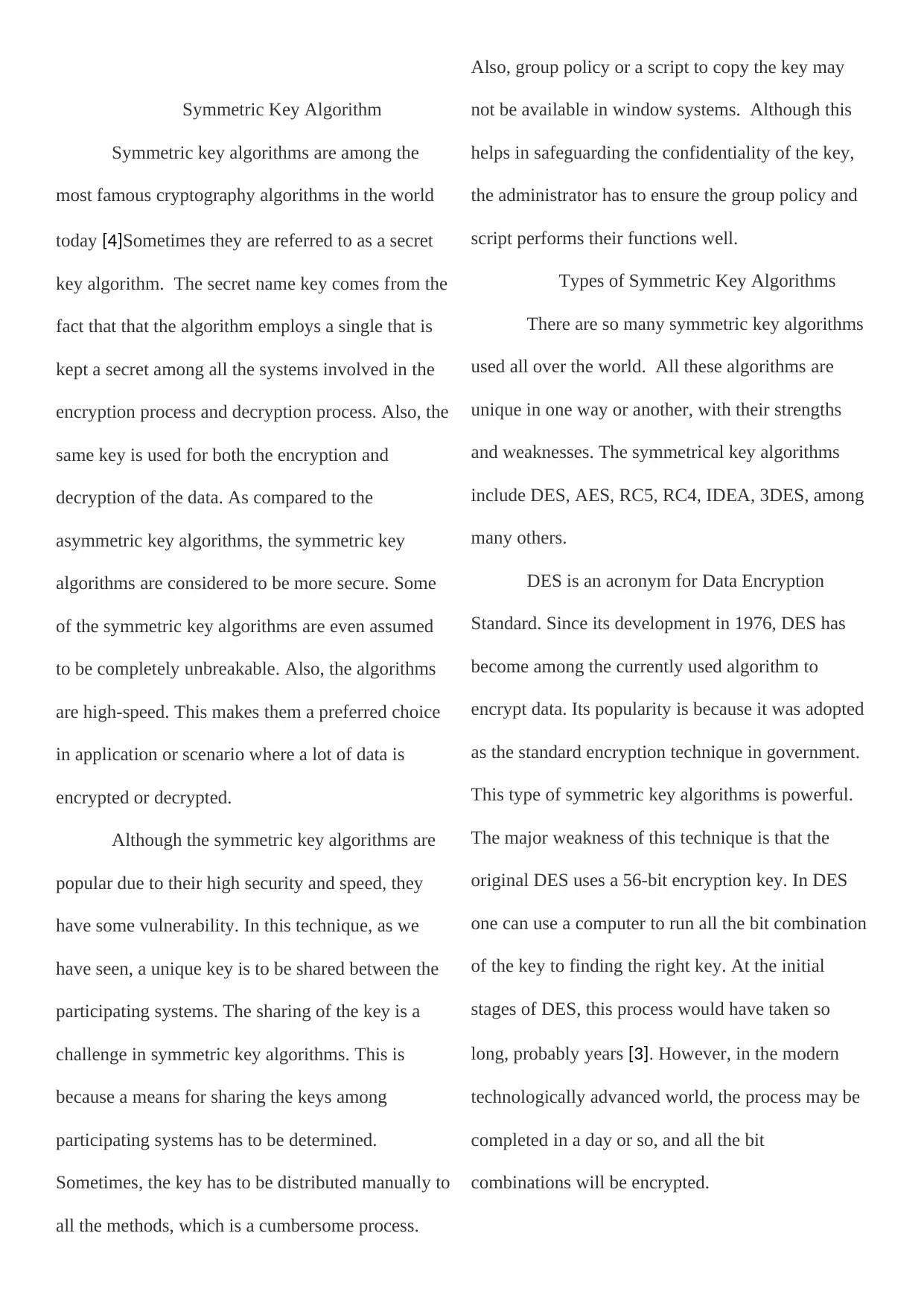
Symmetric Key Algorithm
Symmetric key algorithms are among the
most famous cryptography algorithms in the world
today [4]Sometimes they are referred to as a secret
key algorithm. The secret name key comes from the
fact that that the algorithm employs a single that is
kept a secret among all the systems involved in the
encryption process and decryption process. Also, the
same key is used for both the encryption and
decryption of the data. As compared to the
asymmetric key algorithms, the symmetric key
algorithms are considered to be more secure. Some
of the symmetric key algorithms are even assumed
to be completely unbreakable. Also, the algorithms
are high-speed. This makes them a preferred choice
in application or scenario where a lot of data is
encrypted or decrypted.
Although the symmetric key algorithms are
popular due to their high security and speed, they
have some vulnerability. In this technique, as we
have seen, a unique key is to be shared between the
participating systems. The sharing of the key is a
challenge in symmetric key algorithms. This is
because a means for sharing the keys among
participating systems has to be determined.
Sometimes, the key has to be distributed manually to
all the methods, which is a cumbersome process.
Also, group policy or a script to copy the key may
not be available in window systems. Although this
helps in safeguarding the confidentiality of the key,
the administrator has to ensure the group policy and
script performs their functions well.
Types of Symmetric Key Algorithms
There are so many symmetric key algorithms
used all over the world. All these algorithms are
unique in one way or another, with their strengths
and weaknesses. The symmetrical key algorithms
include DES, AES, RC5, RC4, IDEA, 3DES, among
many others.
DES is an acronym for Data Encryption
Standard. Since its development in 1976, DES has
become among the currently used algorithm to
encrypt data. Its popularity is because it was adopted
as the standard encryption technique in government.
This type of symmetric key algorithms is powerful.
The major weakness of this technique is that the
original DES uses a 56-bit encryption key. In DES
one can use a computer to run all the bit combination
of the key to finding the right key. At the initial
stages of DES, this process would have taken so
long, probably years [3]. However, in the modern
technologically advanced world, the process may be
completed in a day or so, and all the bit
combinations will be encrypted.
Symmetric key algorithms are among the
most famous cryptography algorithms in the world
today [4]Sometimes they are referred to as a secret
key algorithm. The secret name key comes from the
fact that that the algorithm employs a single that is
kept a secret among all the systems involved in the
encryption process and decryption process. Also, the
same key is used for both the encryption and
decryption of the data. As compared to the
asymmetric key algorithms, the symmetric key
algorithms are considered to be more secure. Some
of the symmetric key algorithms are even assumed
to be completely unbreakable. Also, the algorithms
are high-speed. This makes them a preferred choice
in application or scenario where a lot of data is
encrypted or decrypted.
Although the symmetric key algorithms are
popular due to their high security and speed, they
have some vulnerability. In this technique, as we
have seen, a unique key is to be shared between the
participating systems. The sharing of the key is a
challenge in symmetric key algorithms. This is
because a means for sharing the keys among
participating systems has to be determined.
Sometimes, the key has to be distributed manually to
all the methods, which is a cumbersome process.
Also, group policy or a script to copy the key may
not be available in window systems. Although this
helps in safeguarding the confidentiality of the key,
the administrator has to ensure the group policy and
script performs their functions well.
Types of Symmetric Key Algorithms
There are so many symmetric key algorithms
used all over the world. All these algorithms are
unique in one way or another, with their strengths
and weaknesses. The symmetrical key algorithms
include DES, AES, RC5, RC4, IDEA, 3DES, among
many others.
DES is an acronym for Data Encryption
Standard. Since its development in 1976, DES has
become among the currently used algorithm to
encrypt data. Its popularity is because it was adopted
as the standard encryption technique in government.
This type of symmetric key algorithms is powerful.
The major weakness of this technique is that the
original DES uses a 56-bit encryption key. In DES
one can use a computer to run all the bit combination
of the key to finding the right key. At the initial
stages of DES, this process would have taken so
long, probably years [3]. However, in the modern
technologically advanced world, the process may be
completed in a day or so, and all the bit
combinations will be encrypted.
⊘ This is a preview!⊘
Do you want full access?
Subscribe today to unlock all pages.

Trusted by 1+ million students worldwide
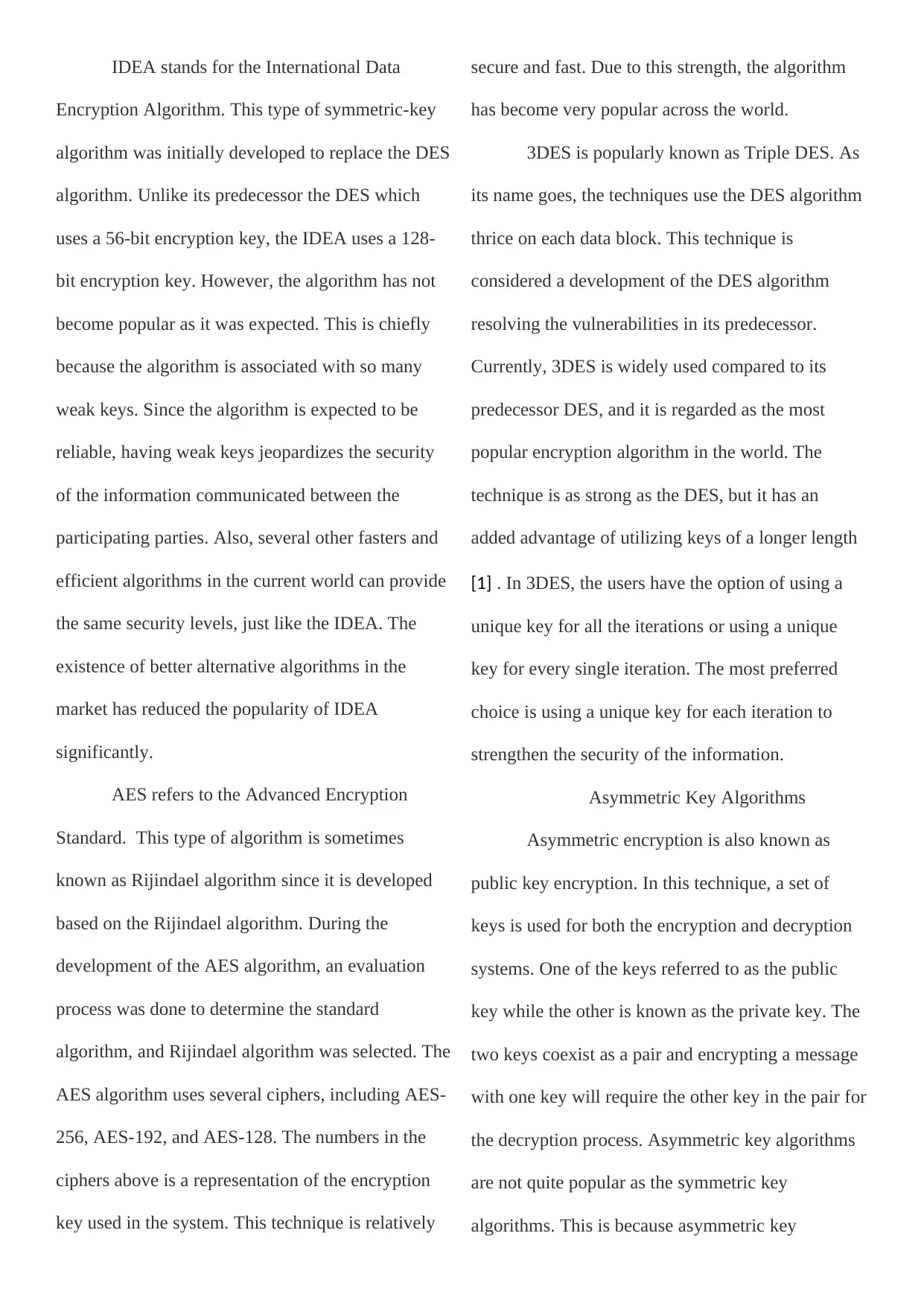
IDEA stands for the International Data
Encryption Algorithm. This type of symmetric-key
algorithm was initially developed to replace the DES
algorithm. Unlike its predecessor the DES which
uses a 56-bit encryption key, the IDEA uses a 128-
bit encryption key. However, the algorithm has not
become popular as it was expected. This is chiefly
because the algorithm is associated with so many
weak keys. Since the algorithm is expected to be
reliable, having weak keys jeopardizes the security
of the information communicated between the
participating parties. Also, several other fasters and
efficient algorithms in the current world can provide
the same security levels, just like the IDEA. The
existence of better alternative algorithms in the
market has reduced the popularity of IDEA
significantly.
AES refers to the Advanced Encryption
Standard. This type of algorithm is sometimes
known as Rijindael algorithm since it is developed
based on the Rijindael algorithm. During the
development of the AES algorithm, an evaluation
process was done to determine the standard
algorithm, and Rijindael algorithm was selected. The
AES algorithm uses several ciphers, including AES-
256, AES-192, and AES-128. The numbers in the
ciphers above is a representation of the encryption
key used in the system. This technique is relatively
secure and fast. Due to this strength, the algorithm
has become very popular across the world.
3DES is popularly known as Triple DES. As
its name goes, the techniques use the DES algorithm
thrice on each data block. This technique is
considered a development of the DES algorithm
resolving the vulnerabilities in its predecessor.
Currently, 3DES is widely used compared to its
predecessor DES, and it is regarded as the most
popular encryption algorithm in the world. The
technique is as strong as the DES, but it has an
added advantage of utilizing keys of a longer length
[1] . In 3DES, the users have the option of using a
unique key for all the iterations or using a unique
key for every single iteration. The most preferred
choice is using a unique key for each iteration to
strengthen the security of the information.
Asymmetric Key Algorithms
Asymmetric encryption is also known as
public key encryption. In this technique, a set of
keys is used for both the encryption and decryption
systems. One of the keys referred to as the public
key while the other is known as the private key. The
two keys coexist as a pair and encrypting a message
with one key will require the other key in the pair for
the decryption process. Asymmetric key algorithms
are not quite popular as the symmetric key
algorithms. This is because asymmetric key
Encryption Algorithm. This type of symmetric-key
algorithm was initially developed to replace the DES
algorithm. Unlike its predecessor the DES which
uses a 56-bit encryption key, the IDEA uses a 128-
bit encryption key. However, the algorithm has not
become popular as it was expected. This is chiefly
because the algorithm is associated with so many
weak keys. Since the algorithm is expected to be
reliable, having weak keys jeopardizes the security
of the information communicated between the
participating parties. Also, several other fasters and
efficient algorithms in the current world can provide
the same security levels, just like the IDEA. The
existence of better alternative algorithms in the
market has reduced the popularity of IDEA
significantly.
AES refers to the Advanced Encryption
Standard. This type of algorithm is sometimes
known as Rijindael algorithm since it is developed
based on the Rijindael algorithm. During the
development of the AES algorithm, an evaluation
process was done to determine the standard
algorithm, and Rijindael algorithm was selected. The
AES algorithm uses several ciphers, including AES-
256, AES-192, and AES-128. The numbers in the
ciphers above is a representation of the encryption
key used in the system. This technique is relatively
secure and fast. Due to this strength, the algorithm
has become very popular across the world.
3DES is popularly known as Triple DES. As
its name goes, the techniques use the DES algorithm
thrice on each data block. This technique is
considered a development of the DES algorithm
resolving the vulnerabilities in its predecessor.
Currently, 3DES is widely used compared to its
predecessor DES, and it is regarded as the most
popular encryption algorithm in the world. The
technique is as strong as the DES, but it has an
added advantage of utilizing keys of a longer length
[1] . In 3DES, the users have the option of using a
unique key for all the iterations or using a unique
key for every single iteration. The most preferred
choice is using a unique key for each iteration to
strengthen the security of the information.
Asymmetric Key Algorithms
Asymmetric encryption is also known as
public key encryption. In this technique, a set of
keys is used for both the encryption and decryption
systems. One of the keys referred to as the public
key while the other is known as the private key. The
two keys coexist as a pair and encrypting a message
with one key will require the other key in the pair for
the decryption process. Asymmetric key algorithms
are not quite popular as the symmetric key
algorithms. This is because asymmetric key
Paraphrase This Document
Need a fresh take? Get an instant paraphrase of this document with our AI Paraphraser
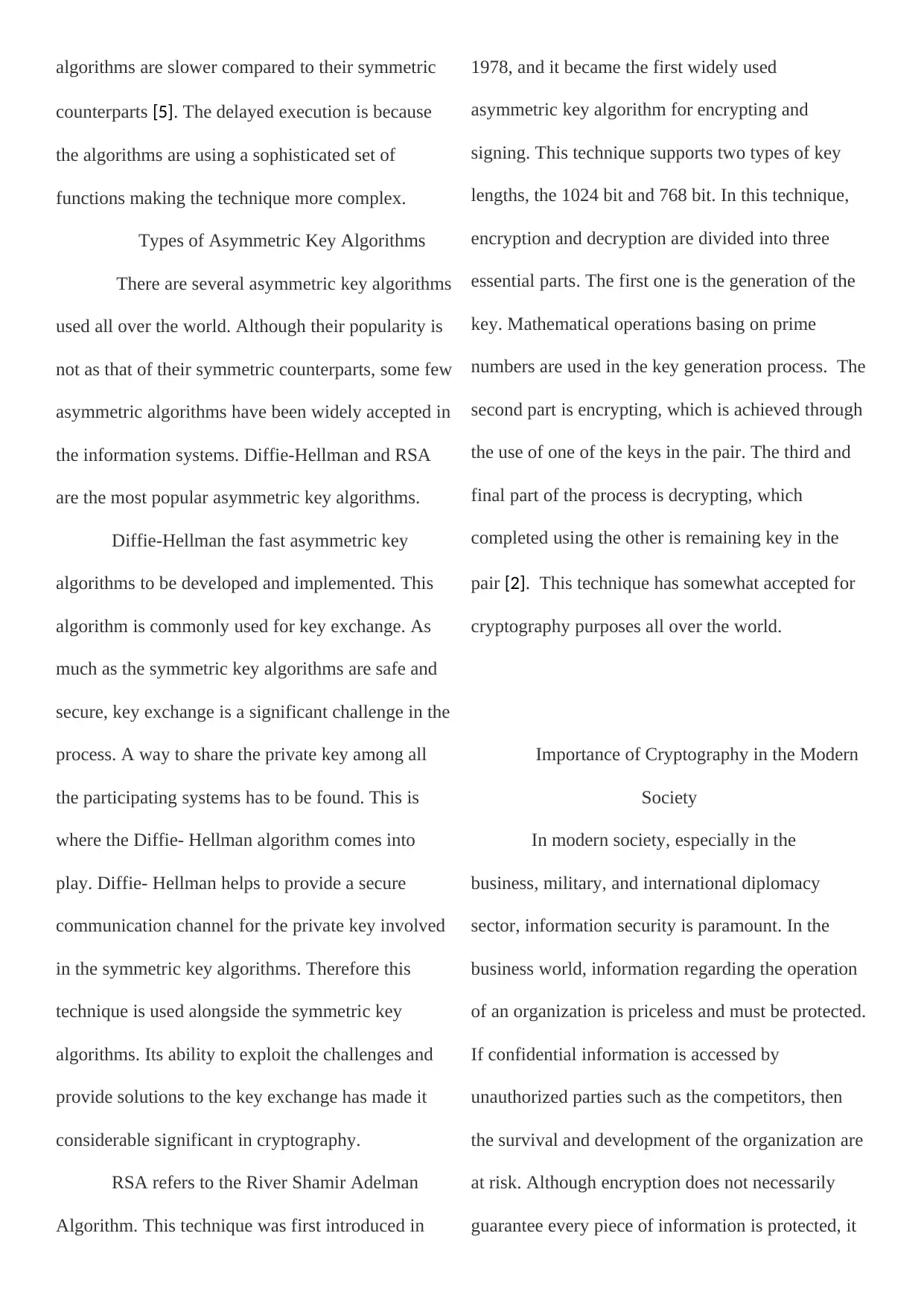
algorithms are slower compared to their symmetric
counterparts [5]. The delayed execution is because
the algorithms are using a sophisticated set of
functions making the technique more complex.
Types of Asymmetric Key Algorithms
There are several asymmetric key algorithms
used all over the world. Although their popularity is
not as that of their symmetric counterparts, some few
asymmetric algorithms have been widely accepted in
the information systems. Diffie-Hellman and RSA
are the most popular asymmetric key algorithms.
Diffie-Hellman the fast asymmetric key
algorithms to be developed and implemented. This
algorithm is commonly used for key exchange. As
much as the symmetric key algorithms are safe and
secure, key exchange is a significant challenge in the
process. A way to share the private key among all
the participating systems has to be found. This is
where the Diffie- Hellman algorithm comes into
play. Diffie- Hellman helps to provide a secure
communication channel for the private key involved
in the symmetric key algorithms. Therefore this
technique is used alongside the symmetric key
algorithms. Its ability to exploit the challenges and
provide solutions to the key exchange has made it
considerable significant in cryptography.
RSA refers to the River Shamir Adelman
Algorithm. This technique was first introduced in
1978, and it became the first widely used
asymmetric key algorithm for encrypting and
signing. This technique supports two types of key
lengths, the 1024 bit and 768 bit. In this technique,
encryption and decryption are divided into three
essential parts. The first one is the generation of the
key. Mathematical operations basing on prime
numbers are used in the key generation process. The
second part is encrypting, which is achieved through
the use of one of the keys in the pair. The third and
final part of the process is decrypting, which
completed using the other is remaining key in the
pair [2]. This technique has somewhat accepted for
cryptography purposes all over the world.
Importance of Cryptography in the Modern
Society
In modern society, especially in the
business, military, and international diplomacy
sector, information security is paramount. In the
business world, information regarding the operation
of an organization is priceless and must be protected.
If confidential information is accessed by
unauthorized parties such as the competitors, then
the survival and development of the organization are
at risk. Although encryption does not necessarily
guarantee every piece of information is protected, it
counterparts [5]. The delayed execution is because
the algorithms are using a sophisticated set of
functions making the technique more complex.
Types of Asymmetric Key Algorithms
There are several asymmetric key algorithms
used all over the world. Although their popularity is
not as that of their symmetric counterparts, some few
asymmetric algorithms have been widely accepted in
the information systems. Diffie-Hellman and RSA
are the most popular asymmetric key algorithms.
Diffie-Hellman the fast asymmetric key
algorithms to be developed and implemented. This
algorithm is commonly used for key exchange. As
much as the symmetric key algorithms are safe and
secure, key exchange is a significant challenge in the
process. A way to share the private key among all
the participating systems has to be found. This is
where the Diffie- Hellman algorithm comes into
play. Diffie- Hellman helps to provide a secure
communication channel for the private key involved
in the symmetric key algorithms. Therefore this
technique is used alongside the symmetric key
algorithms. Its ability to exploit the challenges and
provide solutions to the key exchange has made it
considerable significant in cryptography.
RSA refers to the River Shamir Adelman
Algorithm. This technique was first introduced in
1978, and it became the first widely used
asymmetric key algorithm for encrypting and
signing. This technique supports two types of key
lengths, the 1024 bit and 768 bit. In this technique,
encryption and decryption are divided into three
essential parts. The first one is the generation of the
key. Mathematical operations basing on prime
numbers are used in the key generation process. The
second part is encrypting, which is achieved through
the use of one of the keys in the pair. The third and
final part of the process is decrypting, which
completed using the other is remaining key in the
pair [2]. This technique has somewhat accepted for
cryptography purposes all over the world.
Importance of Cryptography in the Modern
Society
In modern society, especially in the
business, military, and international diplomacy
sector, information security is paramount. In the
business world, information regarding the operation
of an organization is priceless and must be protected.
If confidential information is accessed by
unauthorized parties such as the competitors, then
the survival and development of the organization are
at risk. Although encryption does not necessarily
guarantee every piece of information is protected, it
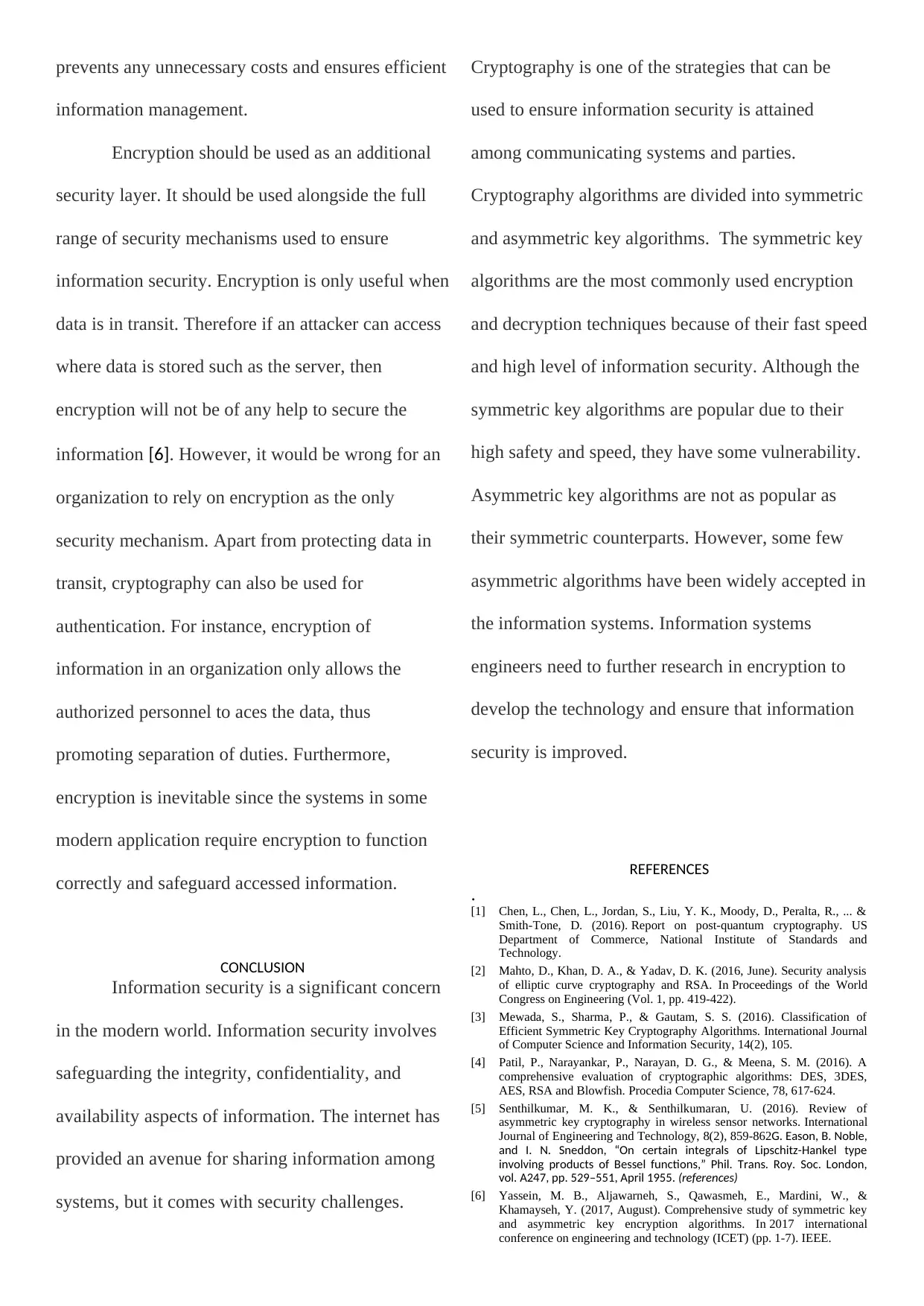
prevents any unnecessary costs and ensures efficient
information management.
Encryption should be used as an additional
security layer. It should be used alongside the full
range of security mechanisms used to ensure
information security. Encryption is only useful when
data is in transit. Therefore if an attacker can access
where data is stored such as the server, then
encryption will not be of any help to secure the
information [6]. However, it would be wrong for an
organization to rely on encryption as the only
security mechanism. Apart from protecting data in
transit, cryptography can also be used for
authentication. For instance, encryption of
information in an organization only allows the
authorized personnel to aces the data, thus
promoting separation of duties. Furthermore,
encryption is inevitable since the systems in some
modern application require encryption to function
correctly and safeguard accessed information.
CONCLUSION
Information security is a significant concern
in the modern world. Information security involves
safeguarding the integrity, confidentiality, and
availability aspects of information. The internet has
provided an avenue for sharing information among
systems, but it comes with security challenges.
Cryptography is one of the strategies that can be
used to ensure information security is attained
among communicating systems and parties.
Cryptography algorithms are divided into symmetric
and asymmetric key algorithms. The symmetric key
algorithms are the most commonly used encryption
and decryption techniques because of their fast speed
and high level of information security. Although the
symmetric key algorithms are popular due to their
high safety and speed, they have some vulnerability.
Asymmetric key algorithms are not as popular as
their symmetric counterparts. However, some few
asymmetric algorithms have been widely accepted in
the information systems. Information systems
engineers need to further research in encryption to
develop the technology and ensure that information
security is improved.
REFERENCES
.
[1] Chen, L., Chen, L., Jordan, S., Liu, Y. K., Moody, D., Peralta, R., ... &
Smith-Tone, D. (2016). Report on post-quantum cryptography. US
Department of Commerce, National Institute of Standards and
Technology.
[2] Mahto, D., Khan, D. A., & Yadav, D. K. (2016, June). Security analysis
of elliptic curve cryptography and RSA. In Proceedings of the World
Congress on Engineering (Vol. 1, pp. 419-422).
[3] Mewada, S., Sharma, P., & Gautam, S. S. (2016). Classification of
Efficient Symmetric Key Cryptography Algorithms. International Journal
of Computer Science and Information Security, 14(2), 105.
[4] Patil, P., Narayankar, P., Narayan, D. G., & Meena, S. M. (2016). A
comprehensive evaluation of cryptographic algorithms: DES, 3DES,
AES, RSA and Blowfish. Procedia Computer Science, 78, 617-624.
[5] Senthilkumar, M. K., & Senthilkumaran, U. (2016). Review of
asymmetric key cryptography in wireless sensor networks. International
Journal of Engineering and Technology, 8(2), 859-862G. Eason, B. Noble,
and I. N. Sneddon, “On certain integrals of Lipschitz-Hankel type
involving products of Bessel functions,” Phil. Trans. Roy. Soc. London,
vol. A247, pp. 529–551, April 1955. (references)
[6] Yassein, M. B., Aljawarneh, S., Qawasmeh, E., Mardini, W., &
Khamayseh, Y. (2017, August). Comprehensive study of symmetric key
and asymmetric key encryption algorithms. In 2017 international
conference on engineering and technology (ICET) (pp. 1-7). IEEE.
information management.
Encryption should be used as an additional
security layer. It should be used alongside the full
range of security mechanisms used to ensure
information security. Encryption is only useful when
data is in transit. Therefore if an attacker can access
where data is stored such as the server, then
encryption will not be of any help to secure the
information [6]. However, it would be wrong for an
organization to rely on encryption as the only
security mechanism. Apart from protecting data in
transit, cryptography can also be used for
authentication. For instance, encryption of
information in an organization only allows the
authorized personnel to aces the data, thus
promoting separation of duties. Furthermore,
encryption is inevitable since the systems in some
modern application require encryption to function
correctly and safeguard accessed information.
CONCLUSION
Information security is a significant concern
in the modern world. Information security involves
safeguarding the integrity, confidentiality, and
availability aspects of information. The internet has
provided an avenue for sharing information among
systems, but it comes with security challenges.
Cryptography is one of the strategies that can be
used to ensure information security is attained
among communicating systems and parties.
Cryptography algorithms are divided into symmetric
and asymmetric key algorithms. The symmetric key
algorithms are the most commonly used encryption
and decryption techniques because of their fast speed
and high level of information security. Although the
symmetric key algorithms are popular due to their
high safety and speed, they have some vulnerability.
Asymmetric key algorithms are not as popular as
their symmetric counterparts. However, some few
asymmetric algorithms have been widely accepted in
the information systems. Information systems
engineers need to further research in encryption to
develop the technology and ensure that information
security is improved.
REFERENCES
.
[1] Chen, L., Chen, L., Jordan, S., Liu, Y. K., Moody, D., Peralta, R., ... &
Smith-Tone, D. (2016). Report on post-quantum cryptography. US
Department of Commerce, National Institute of Standards and
Technology.
[2] Mahto, D., Khan, D. A., & Yadav, D. K. (2016, June). Security analysis
of elliptic curve cryptography and RSA. In Proceedings of the World
Congress on Engineering (Vol. 1, pp. 419-422).
[3] Mewada, S., Sharma, P., & Gautam, S. S. (2016). Classification of
Efficient Symmetric Key Cryptography Algorithms. International Journal
of Computer Science and Information Security, 14(2), 105.
[4] Patil, P., Narayankar, P., Narayan, D. G., & Meena, S. M. (2016). A
comprehensive evaluation of cryptographic algorithms: DES, 3DES,
AES, RSA and Blowfish. Procedia Computer Science, 78, 617-624.
[5] Senthilkumar, M. K., & Senthilkumaran, U. (2016). Review of
asymmetric key cryptography in wireless sensor networks. International
Journal of Engineering and Technology, 8(2), 859-862G. Eason, B. Noble,
and I. N. Sneddon, “On certain integrals of Lipschitz-Hankel type
involving products of Bessel functions,” Phil. Trans. Roy. Soc. London,
vol. A247, pp. 529–551, April 1955. (references)
[6] Yassein, M. B., Aljawarneh, S., Qawasmeh, E., Mardini, W., &
Khamayseh, Y. (2017, August). Comprehensive study of symmetric key
and asymmetric key encryption algorithms. In 2017 international
conference on engineering and technology (ICET) (pp. 1-7). IEEE.
⊘ This is a preview!⊘
Do you want full access?
Subscribe today to unlock all pages.

Trusted by 1+ million students worldwide
1 out of 6
Related Documents
Your All-in-One AI-Powered Toolkit for Academic Success.
+13062052269
info@desklib.com
Available 24*7 on WhatsApp / Email
![[object Object]](/_next/static/media/star-bottom.7253800d.svg)
Unlock your academic potential
Copyright © 2020–2025 A2Z Services. All Rights Reserved. Developed and managed by ZUCOL.



